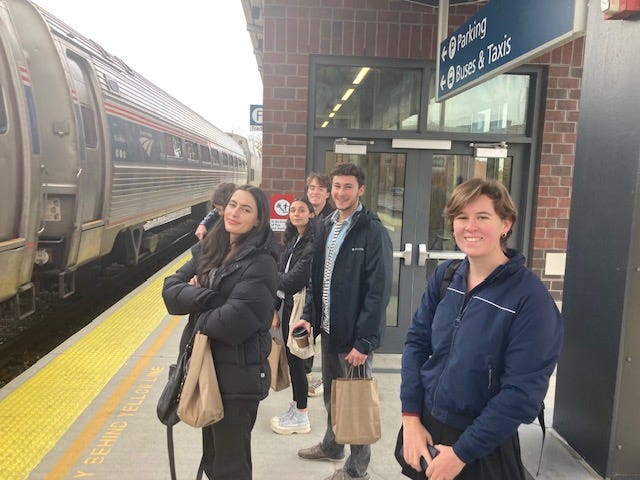
This past weekend, Professor Martine Guyot-Bender and her students took part in a day-long trip to Schenectady as part of their class’s experiential learning component. French and Francophone Studies 307: All Aboard The French Train! takes the study of this pioneering mode of transportation to a new level. Through the use of various social, political, economic and historical lenses, students have the opportunity to explore the impacts of the French railway system. Although taught in French, the scope of the class goes further than that of the French mainland, weaving in the importance of trains within former French colonies and 19th century American expansionism. From the train’s technological prowess to its risks as a metaphorical weapon — without forgetting the potential for sociability and its architectural heritage — Guyot-Bender’s deep dive into the world of railroads reaches far beyond the classroom. Through this trip, students were able to make real-world connections with class material and enjoy discovering the quaint city of Schenectady, NY.
Departing Hamilton at 10:00 a.m., Professor Guyot-Bender and her students boarded an Amtrak train leaving Utica. A former Dutch and French town, Schenectady was home to the Mohawk and Hudson Railroad, the first chartered railroad built in the state of New York and the first of its kind on a national scale. Founded in 1831, the railroad significantly cut passengers’ travel time from Albany to Schenectady to a one-hour long trip, bypassing a 24 hour-long voyage using the Erie Canal. Given its significance to history and the class, Schenectady was the ideal destination for this experiential learning experience.
While on the hour and fifteen minute ride, students were advised to keep in mind several key points pertinent to class material, including the station’s architecture and its geographical location, the train’s speed, the outside world perceived from within and various sounds emitted by the train. The combination of sensory experiences and thoughtful reflection gave students the chance to draw connections between the experience of an American train and those studied in France. Once they arrived at their destination, the class explored Schenectady’s historic district, strolling through its quiet downtown streets. Among its many consequent historical landmarks, the district holds a multitude of antique row houses built over two centuries ago which especially drew admiration from the class. Prof. Guyot-Bender and her students then made their way to the Mohawk River, known to be the largest tributary of the Hudson River, and runs parallel to the Schenectady train line. Following this, the class stopped in front of St. George’s Church, the oldest religious building in Schenectady, built in 1759. Before heading back to the station, the class enjoyed snacks and refreshments inside the Moon and River Café, a small Schenectady-based coffee shop that provided a chance to chat with the shopkeeper and learn more about the city. Before boarding, Prof. Guyot-Bender made sure to take a picture in front of the station’s main facade as a souvenir of this successful trip.
Last month, Guyot-Bender and her students also traveled to Utica where they had class inside the train station with the help of Hamilton guest lecturer and Utica native, Phil Bean. A specialist of Utica’s railroad history, Bean explained the significance of railroads during the 19th century and its place within society nowadays. Further, since Bean’s close family was involved with the railroad industry for several decades, his unique perspective was very much welcome. Looking into the future, French 307 will also have the pleasure of welcoming several guest speakers from France over Zoom, who will be able to discuss the place passenger trains hold within their local communities. Throughout these diverse immersive experiences, Prof. Guyot-Bender and her class expand their horizons, develop their analytical skills and enrich their understanding of the railways system within France and beyond.
















